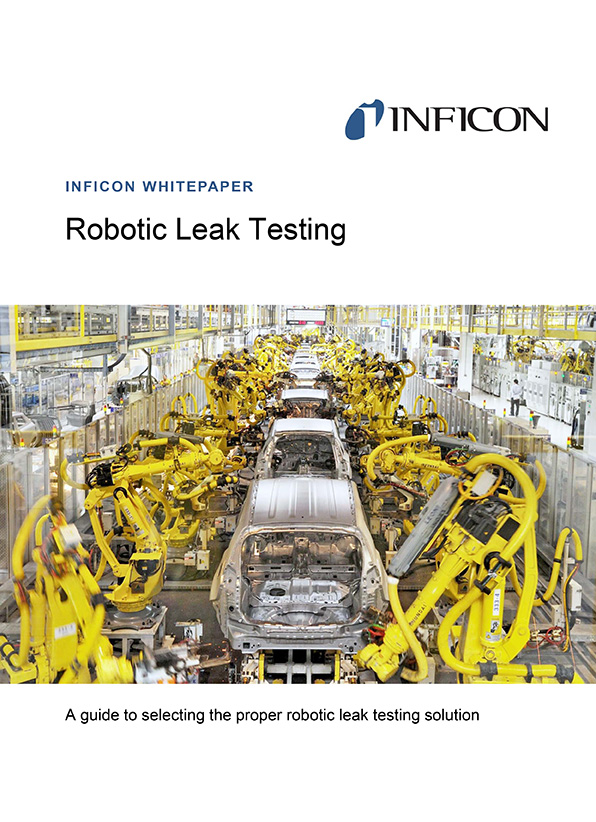5 Tips for Robotic Leak Testing
In many manufacturing processes robotic sniffer leak detection provides efficient reliable, operator-independent testing. Modern sniffer leak detectors determine whether a test gas is escaping from any leaks. They determine the exact size of the leak and where it is located. Sniffer leak detection often serves to ensure that the joints between already assembled components are actually tight. In automotive engineering, for example, a typical application is the leak test of pre-assembled air conditioning components - before they are finally installed in the vehicle – to ensure that no refrigerant escapes from the air conditioning system for many years to come. For maximum efficiency, it makes sense to automate many of these testing tasks in production by using robots to move the probe tip of the sniffer leak detector.
1. Robots are not human beings
In manual sniffer leak testing, it is the operator's task to hold - or guide - the probe at a suitable distance over the surface of the component to be tested: close enough without touching or damaging the surface. For experienced operators, it is no problem to compensate for any component tolerances. But robots are not human beings; a robot arm does not perceive small differences between components. It must therefore be programmed to always maintain a certain safety distance from the surface. However, the safety distance should be kept as low as possible as with increasing distance from the leak, the risk of missing it increases. Higher flow leak detectors typically can cope with a larger distance than low flow leak detectors.
2. What works when stationary can fail when moving
The problem of too large a distance becomes even more acute if the probe is not held statically above a certain point, but must be moved over a larger surface, for example along welds or seals. Speed, surface distance and gas flow are decisive factors, especially when testing against comparatively small leakage rates - such as 10-3 mbar∙l/s to rule out oil leaks. The sniffer leak detector must draw in air with a certain gas flow to be able to detect escaping test gas. Conventional sniffer leak detectors that work with a gas flow of only 60 sccm (standard cubic centimeter per minute) cannot detect oil leaks at a surface distance of 6 mm, even if the measuring tip remains completely still above the leak. In contrast, devices with a high gas flow of 3000 sccm detect these leaks 100 percent of the time, even during a dynamic sniffer leak testing. High gas flow is essential for successful robotic sniffer leak testing.
3. The lower the limit leakage rate, the lower the possible speed
If the oil tightness of a component is to be ensured, a test against leakage rates in the range of 10-3 mbar∙l/s is required. Often, however, the limit leakage rates must be even smaller. If, for example, liquid fuels must be prevented from escaping from components in automotive engineering, the test should be carried out against a leakage rate in the range of 10-4 mbar∙l/s. Testing for smaller leak rates presents a higher challenge in dynamic robotic leak testing. It often makes sense to reduce the speed of the measuring probe. Experience shows that in an example like ours, with a safety distance of 6 mm from the surface, a scan speed of no more than 10 cm/s is advisable - even if the leak detector works with a high gas flow of 3000 sccm.
4. Selecting the right test gas for the intended use
Forming gas (a non-combustible mixture of 95% nitrogen and 5% hydrogen) and helium are probably the two most common test gases. The advantage of forming gas is its high availability at low cost. But in some applications helium is the better choice. In our example (dynamic sniffer leak testing for oil leaks at a distance of 6 mm to 10-3 mbar∙l/s), helium allows for higher scan speeds and higher throughput compared to using forming gas. It is therefore worth choosing your priorities: lower costs for the test gas or higher process speed.
5. Only enclosures protect against draughts

In many production environments there is naturally a certain amount of draught. Unfortunately, wind is the natural enemy of sniffing leaks: there is always the danger that the air draught will quickly blow away test gas clouds and thus prevent the reliable detection and safe localization of a leak. For this reason, it makes sense to enclose the area in which the test is to take place. In automated dynamic sniffer leak testing, the robot arm is often enclosed for safety reasons, but the reliability of manual sniffer leak detection is also significantly increased by enclosing the test station. Although test devices with a high gas flow always help reduce problems caused by a possible draft of air, housing the station for sniffer leak detection is always a good idea to assure maximum efficiency.
To learn more about Robotic Leak Testing, please also download our free whitepaper on Robotic Leak Testing.